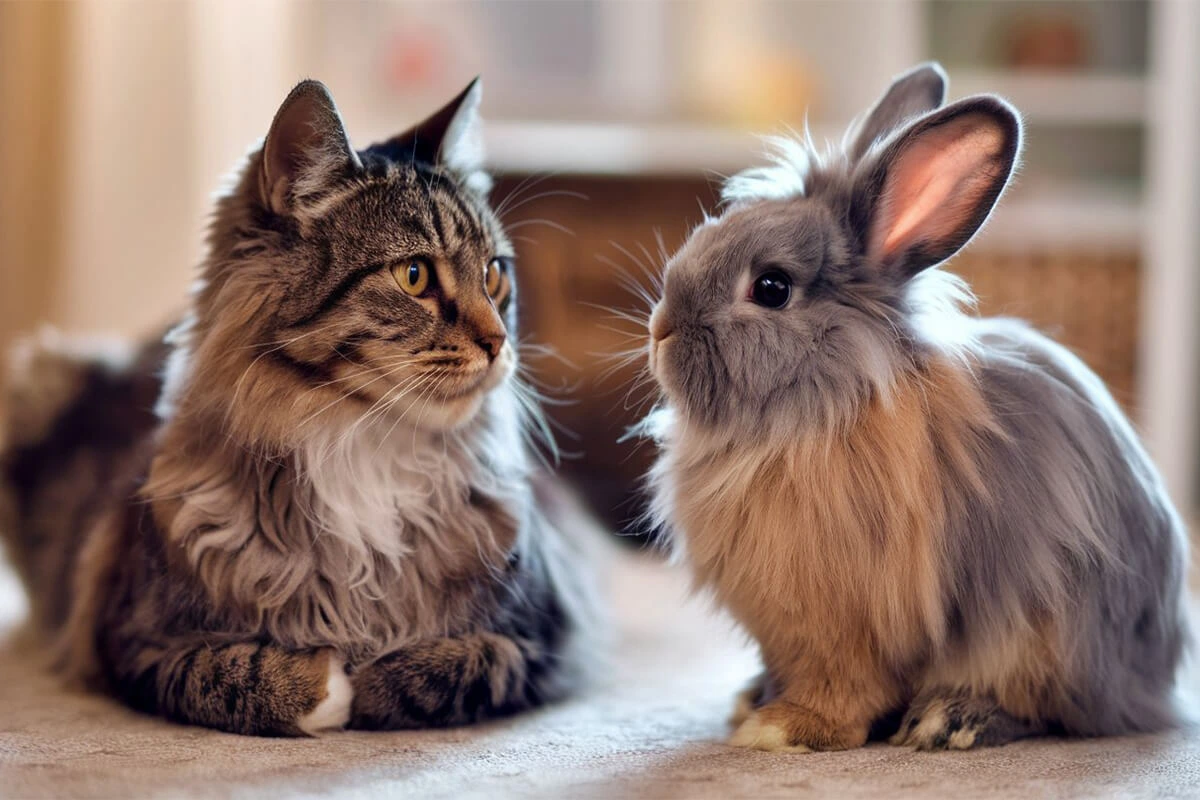Many pet owners wonder, can a cat and bunny live together peacefully? The idea of having both animals in the same home might seem risky, especially since cats are natural hunters, and rabbits are prey animals. However, with the right approach, patience, and proper introductions, a cat and bunny can form a strong bond and coexist in harmony.
Before bringing these two pets together, it’s important to understand their instincts, behaviors, and potential challenges. Some cats have a strong prey drive, while others may be more relaxed and open to new companions. Rabbits, on the other hand, can be cautious but also surprisingly social. Their ability to get along depends on their personalities, past experiences, and how their owner manages the introduction process.
This guide will provide ten essential tips to help create a safe, happy, and stress-free home for both pets. From setting up a secure environment to introducing them properly and ensuring positive interactions, these steps will help foster a healthy relationship between your cat and bunny.
Can Cats and Bunnies Be Friends? Understanding Their Natural Behavior
Instincts and Differences
Cats and rabbits have completely different instincts and ways of interacting with the world. Cats are natural hunters, even if they have never lived in the wild. Their instincts drive them to stalk, chase, and pounce on smaller, fast-moving animals. This doesn’t mean every cat will see a rabbit as prey, but it’s important to recognize that their natural behaviors can influence how they respond to a new bunny in the home.
Rabbits, on the other hand, are prey animals. Their survival instincts tell them to be cautious, especially around larger animals. A sudden movement or loud noise can trigger their flight response, making them run or hide. However, rabbits are also highly social and can form bonds with other animals, including cats, if they feel safe and comfortable.
Understanding these differences helps set the stage for a successful introduction. Not every cat will want to chase a rabbit, and not every bunny will fear a cat, but recognizing their natural tendencies makes it easier to guide their interactions in a positive direction.
Potential Risks and Challenges
Bringing a cat and bunny together requires careful planning because their instincts can sometimes create challenges. One of the biggest risks is a cat’s prey drive. Even a well-behaved cat might suddenly react to a rabbit’s quick movements. Kittens and younger cats, who tend to be more playful and energetic, may see a rabbit as a toy rather than a companion.
Size differences also matter. A large rabbit might intimidate a small cat, while a tiny rabbit could be vulnerable to accidental rough play. Some cats enjoy batting at objects with their paws, and even a gentle swat could hurt a rabbit. Claws and teeth can cause serious injuries, so direct interactions should always happen under supervision.
Another challenge involves territorial behavior. Cats often see new animals as intruders, especially if they have never shared their space before. They may hiss, swat, or even stalk the rabbit at first. Rabbits can also be territorial, especially unneutered males who may become aggressive if they feel threatened. Creating a neutral meeting space and gradually introducing them can help prevent conflicts.
Signs of a Positive Interaction
A successful bond between a cat and bunny doesn’t happen overnight, but certain behaviors show that they are beginning to accept each other. Curiosity is a great first sign. If your cat watches the rabbit without showing signs of aggression—such as flattened ears, a flicking tail, or dilated pupils—it means they are interested rather than seeing the bunny as prey.
A relaxed body posture in both animals is another good sign. If the rabbit doesn’t immediately run away and the cat doesn’t go into a hunting stance, they are getting comfortable. Some bunnies even approach a cat out of curiosity, sniffing them or nudging them gently.
Mutual grooming is one of the strongest signs of a positive relationship. If a rabbit licks a cat or vice versa, it means they are starting to bond. Grooming is how rabbits show affection, and if they feel safe enough to do this with a cat, it signals trust.
A happy home for a cat and bunny starts with understanding their instincts, managing risks, and watching for these positive interactions. With time and patience, these two very different animals can learn to coexist peacefully.
Preparing a Safe and Comfortable Environment
Separate Spaces for Adjustment
Creating separate spaces helps both pets feel safe when introducing a cat and bunny to each other. Cats are territorial and may feel threatened by a new animal in their space, while rabbits need time to feel secure before interacting with a predator species. Giving each pet its own designated area prevents stress and allows them to adjust at their own pace.
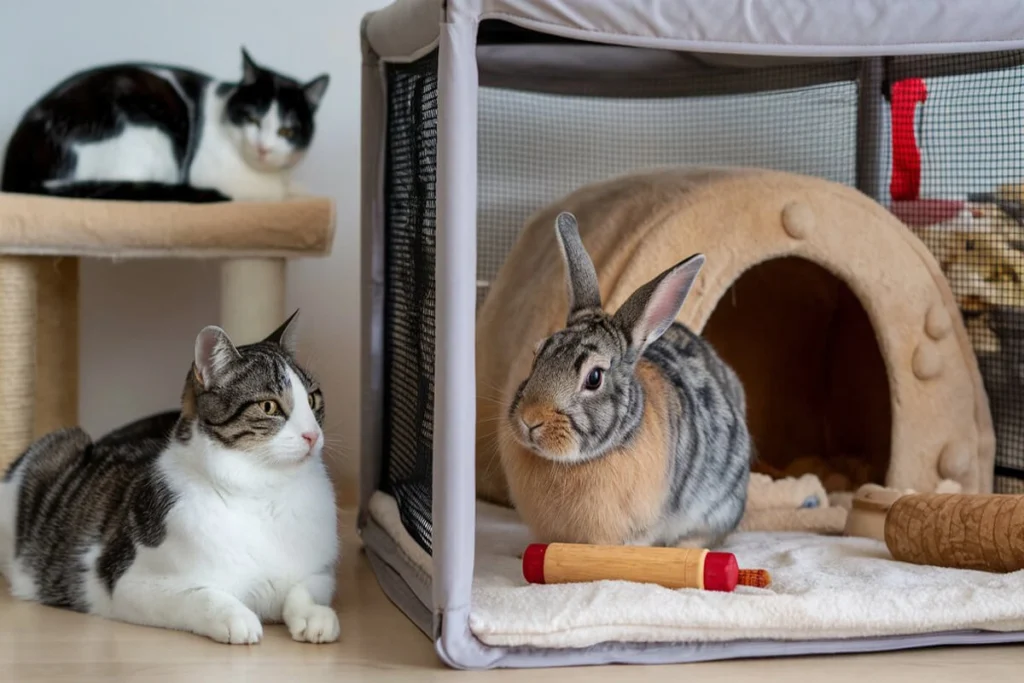
Set up a comfortable enclosure for the rabbit in a quiet area where the cat can see but not reach them. A sturdy playpen, a large cage, or a separate room with a baby gate allows the bunny to explore freely without feeling cornered. Make sure the rabbit has hiding spots, like tunnels or boxes, where they can retreat if they feel nervous.
Let the cat and bunny get used to each other’s presence by allowing them to smell each other through a barrier. Swapping bedding or rubbing a cloth on one pet and placing it near the other helps them become familiar with each other’s scent. Avoid rushing the introduction—allow them to observe each other at a distance before attempting face-to-face interactions.
Supervised Interactions
Once both pets seem comfortable in their separate spaces, introduce them in a controlled setting. Always stay nearby to monitor their body language and step in if needed. The first few meetings should be short and positive to prevent negative associations.
Pick a neutral area where neither pet feels like it belongs there. A small room or a playpen can work well. Keep the rabbit in an enclosure while allowing the cat to approach and observe. If the cat shows signs of hunting behavior, such as crouching, staring intensely, or flicking its tail, gently redirect their attention with a toy or treat.
Let both pets control the pace of the interaction. If the bunny hops over to investigate, watch how the cat responds. A calm, curious reaction means progress, while swatting or chasing requires a reset. Keep these sessions short at first, gradually increasing the duration as both pets grow more comfortable.
Never leave them alone together until you are 100% sure they get along. Even if they seem friendly, accidents can happen. Continue supervised interactions for several weeks or even months before allowing unsupervised contact.
Pet-Proofing Your Home
A cat and bunny living together means making the home safe for both animals. Rabbits love to chew, so electrical cords, furniture, and small objects should be kept out of reach. Use cord protectors or hide wires behind furniture to prevent accidents.
Provide plenty of hiding spaces for the rabbit where the cat cannot reach them. A wooden hideout, a covered litter box, or a raised platform gives the bunny a sense of security. Make sure the cat has high perches or shelves where they can retreat if they want space.
Block off areas where the rabbit could get trapped or stuck, such as under furniture or behind appliances. If the cat has a habit of swatting or pouncing, trim their claws regularly to reduce the risk of injury. Soft nail caps can also help prevent scratches.
Litter boxes should remain separate. Cats and rabbits use different types of litter, and a cat’s litter box may contain bacteria that could harm a rabbit. Keep their food and water dishes in separate areas to avoid competition or territorial behavior.
By setting up a safe environment, introducing them gradually, and supervising their interactions, you can create a home where your cat and bunny coexist peacefully.
How to Introduce a Rabbit to a Cat Safely
Slow and Gradual Introduction
Introducing a rabbit to a cat requires patience. Rushing the process can cause fear, stress, or even aggression. Taking slow, deliberate steps allows both pets to build trust and feel comfortable around each other.
Start by letting them become familiar with each other’s scent before they meet face-to-face. Swap their bedding or rub a cloth on one pet and place it near the other’s resting area. This helps them associate the new scent with something non-threatening.
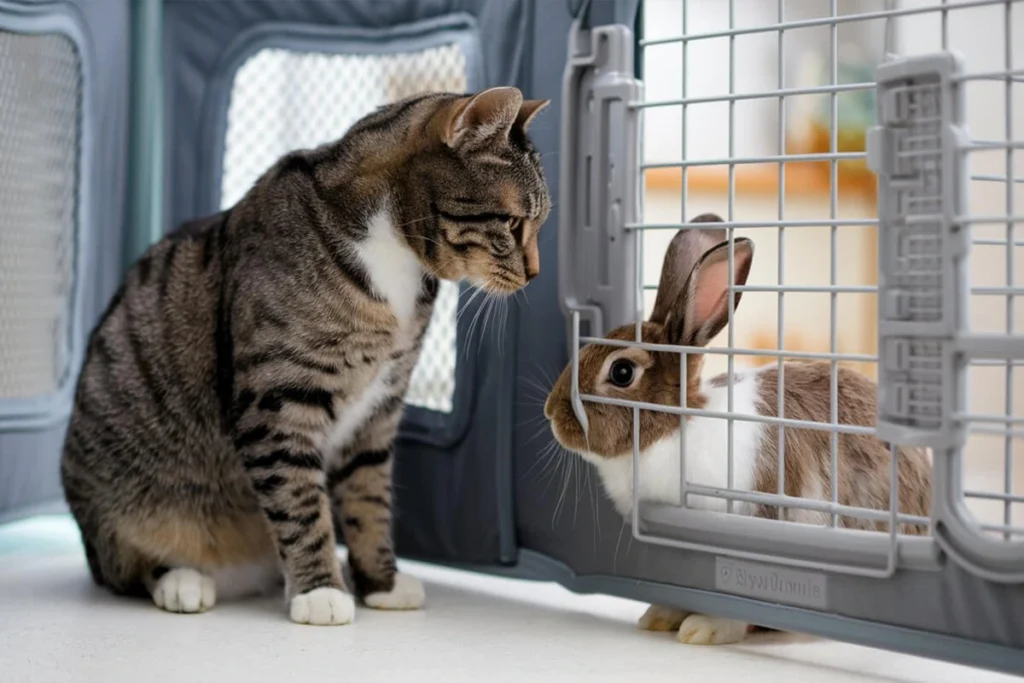
Once they seem comfortable with each other’s scent, allow them to observe one another from a safe distance. Keep the rabbit in a secure enclosure and let the cat see them from across the room. If the cat watches calmly and does not show signs of aggression, gradually move them closer over time. If either pet seems anxious, increase the distance and slow down the process.
Let the introduction sessions be short at first—just a few minutes at a time. Always end each meeting on a positive note before either pet becomes stressed. Increase the duration of their interactions gradually, allowing both animals to set the pace.
Using Barriers for Initial Contact
Using physical barriers provides a safe way for the cat and bunny to see and smell each other without direct contact. A sturdy playpen, baby gate, or wire fence works well for this step. The goal is to let them interact without the risk of sudden movements or unwanted chasing.
Place the rabbit in an enclosed space where they feel secure, such as their pen or a sectioned-off area of a room. Let the cat approach and observe. If the cat gets too excited or shows signs of hunting behavior—like crouching, staring intensely, or flicking its tail—redirect their attention with a toy or treat.
Allow both pets to sniff each other through the barrier. If the bunny hops up to investigate, watch the cat’s reaction closely. A relaxed cat may blink slowly or turn its ears forward, which signals curiosity rather than aggression. If the rabbit remains calm and continues exploring, it shows they are feeling comfortable.
Repeat these sessions daily, gradually decreasing the barrier distance over time. Once both animals appear comfortable, you can move on to supervised face-to-face meetings in a controlled environment.
Positive Reinforcement & Rewards
Encouraging good behavior helps both pets associate their interactions with positive experiences. Whenever the cat and bunny remain calm around each other, reward them with treats, praise, or petting.
If the cat watches the rabbit without lunging or swatting, offer a treat or engage them with a favorite toy to reinforce their calm behavior. For the rabbit, reward relaxed behavior by giving them a small piece of their favorite vegetable or a gentle head rub.
Avoid punishing either pet if they react negatively. Instead, redirect unwanted behavior. If the cat starts stalking or swatting at the rabbit, distract them with a toy or move them to another area. If the rabbit shows signs of fear—such as thumping, running away, or hiding—pause the interaction and give them time to feel safe again.
Consistency is key. Over time, both pets will begin to associate each other with positive interactions rather than stress or fear. By introducing them slowly, using barriers for safety, and reinforcing good behavior, you set the foundation for a peaceful and happy relationship between your cat and bunny.
Encouraging Bonding While Keeping Your Bunny Safe
Monitoring Playtime and Interaction
Supervising playtime between your cat and bunny ensures their interactions stay safe and positive. Even if they appear to get along, their different play styles can create misunderstandings. Cats use their paws to swat and grab, while rabbits prefer gentle nudges and hops to interact. Without supervision, a cat’s playful pounce could startle or even injure the bunny.
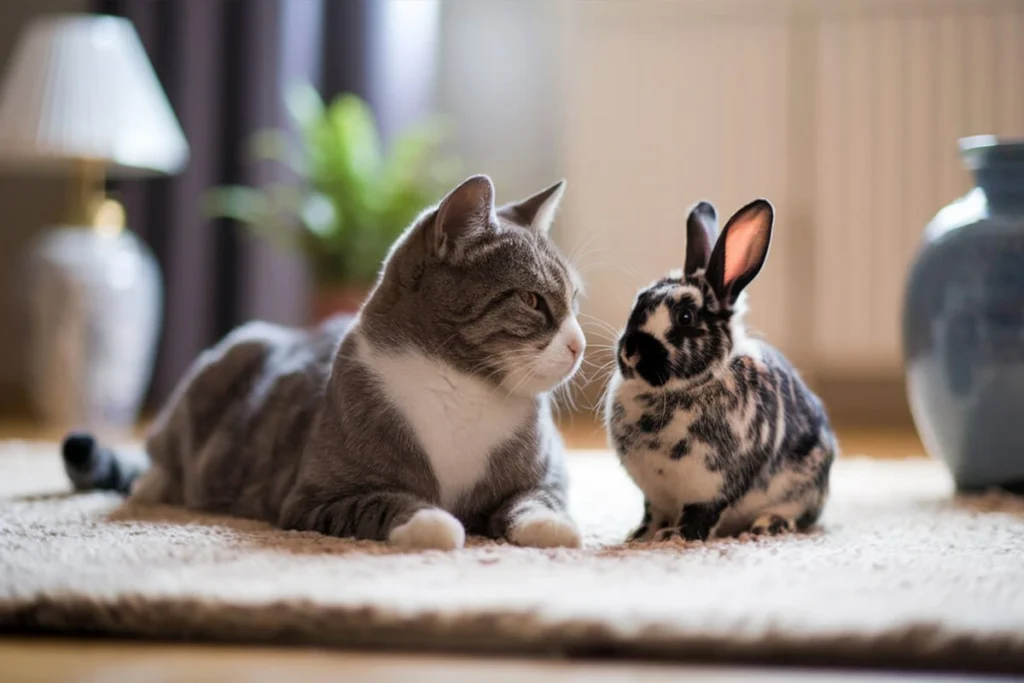
Start with short play sessions in a controlled environment. Keep your cat well-fed and engaged with toys before introducing them to the rabbit. A tired cat is less likely to chase or play rough. Observe how they react to each other—watch for signs of discomfort, fear, or aggression from either pet. If the cat tries to pounce or the rabbit runs away in fear, redirect their attention with a toy or gentle distraction.
Encourage calm behavior by rewarding both pets when they stay relaxed around each other. If they remain comfortable during playtime, gradually increase the length of their interactions. Even as they develop a bond, continue supervising their time together. A sudden movement or unexpected noise could trigger instinctive reactions, leading to stress or conflict.
Training Your Cat to Be Gentle
Teaching your cat to be gentle with the rabbit reduces the risk of accidental harm. Even friendly cats need guidance on how to interact with a much smaller, more fragile companion.
Start by reinforcing calm behavior. If your cat watches the bunny without lunging, reward them with treats or praise. If they approach gently and sniff the rabbit without showing signs of aggression, encourage this behavior with a soft voice and a reward. Over time, your cat will associate good behavior with positive reinforcement.
Discourage rough play immediately. If the cat raises a paw, swats, or attempts to pounce, intervene right away. Use a firm “no” or gently move the cat away. Redirect their energy toward an appropriate toy. Interactive toys, like feather wands or treat puzzles, help satisfy their hunting instincts without involving the bunny.
Trim your cat’s claws regularly to reduce the risk of accidental scratches. If your cat struggles with being too playful, consider using soft nail caps to prevent injuries. Some cats also respond well to clicker training—rewarding good behavior with a click and a treat helps reinforce gentle interactions.
Recognizing When They Should Be Separated
Not every cat and bunny will become best friends, and some interactions may require separation to ensure safety. Recognizing warning signs early prevents stress and potential harm to either pet.
If your cat consistently displays hunting behavior—such as crouching, stalking, or attempting to pounce—it may not be safe to allow unsupervised interactions. Some cats have a strong prey drive that makes it difficult to coexist peacefully with a rabbit. In these cases, keeping them in separate areas of the home may be the best solution.
Watch for signs of stress in your rabbit. If they freeze, thump their back foot repeatedly, or hide excessively, they may feel unsafe around the cat. A stressed rabbit can develop health issues, including digestive problems and reduced appetite. If the rabbit remains fearful despite slow introductions, it’s important to prioritize their well-being by keeping the pets apart when necessary.
Aggressive behavior, such as hissing, swatting, growling, or lunging, signals a need for immediate separation. Even if these behaviors seem minor at first, repeated negative interactions can escalate. If conflicts persist, consult an animal behaviorist for guidance on improving their relationship or ensuring a safe household for both pets.
Building a bond between a cat and bunny takes time, patience, and careful observation. By monitoring their interactions, training your cat to be gentle, and knowing when to step in, you can create a safe and happy environment where both pets feel secure.
Long-Term Coexistence and Care in a Multi-Pet Household
Providing Equal Attention and Care
Ensuring both your cat and bunny receive equal attention prevents jealousy, stress, and behavioral issues. Even if one pet demands more interaction, both animals need love, stimulation, and care to thrive.
Spend quality time with each pet individually. Cats may enjoy cuddling, interactive play with toys, or simply lounging near their owner, while rabbits appreciate gentle petting, floor time, and enrichment activities like tunnels and foraging toys. Make sure to engage in activities that suit each animal’s personality and needs.
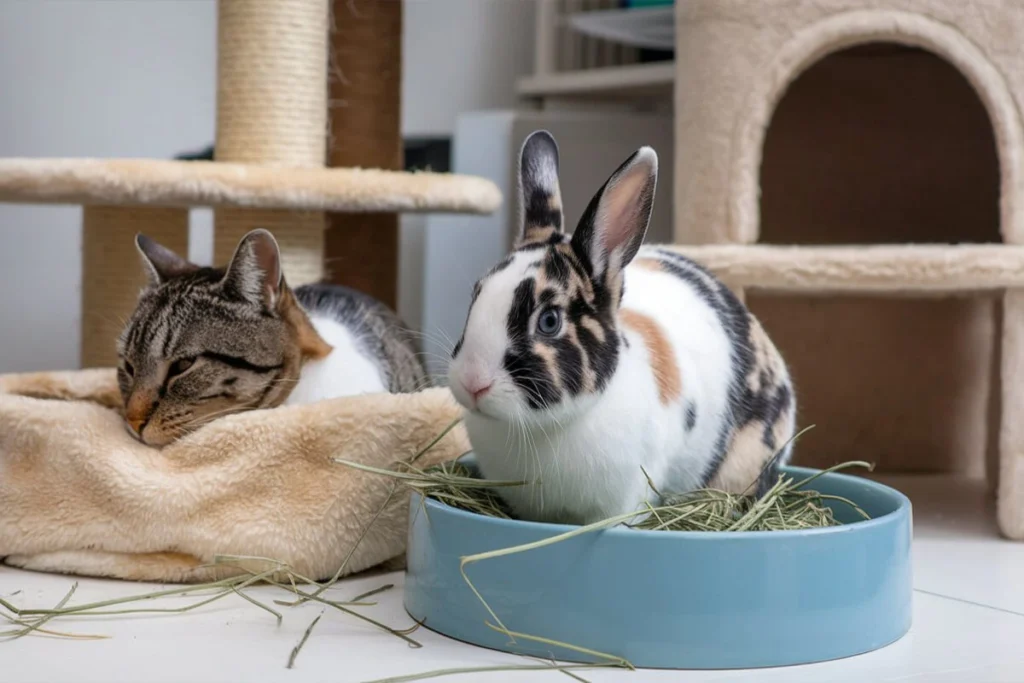
Avoid favoring one pet over the other, especially in shared spaces. If your rabbit feels ignored or if your cat senses competition, they may act out. Offer both pets treats, praise, and attention in a balanced way. If your cat enjoys sitting on your lap while you relax, make time to sit on the floor with your bunny afterward to reinforce fairness.
Ensure both pets have their own spaces for retreating when they want alone time. Cats often appreciate high perches, cat trees, or cozy hiding spots, while rabbits need covered hideouts, tunnels, or designated quiet areas. Allow them to enjoy their own space without interruption while still giving them opportunities to interact on their terms.
Maintaining a Consistent Routine
Establishing a daily routine helps both pets feel secure. Cats and rabbits thrive on predictability, and knowing what to expect each day reduces anxiety and promotes a sense of stability.
Feed both pets at the same times each day, keeping their food and water dishes separate to prevent competition. Rabbits need a diet rich in hay, fresh vegetables, and pellets, while cats require protein-heavy meals. Avoid letting the cat access the rabbit’s food, as some ingredients in rabbit pellets can be harmful to cats.
Schedule playtime, exercise, and bonding moments at consistent times. If your rabbit enjoys morning play sessions, make sure to engage with your cat later in the day to maintain balance. Keep their sleeping and resting areas undisturbed to reinforce a sense of routine and security.
If either pet receives veterinary care, grooming, or other attention, try to handle both animals around the same time to prevent one from feeling neglected. Rabbits need regular nail trims and brushing (especially long-haired breeds), while cats require claw maintenance and occasional grooming. Keeping their care schedules aligned ensures neither pet feels left out.
Handling Conflicts and Behavioral Issues
Even in a well-managed multi-pet household, occasional conflicts can arise. Understanding how to handle disagreements helps maintain peace and prevent long-term issues.
If your cat or rabbit becomes territorial, observe what triggers the behavior. Cats may mark areas with scent, claim resting spots, or block access to certain areas. Rabbits may thump their feet, lunge, or guard their space. Reduce competition by providing separate resting spots, feeding stations, and litter areas to minimize stress.
Address aggressive behavior immediately. If your cat swats at the rabbit or the rabbit lunges in fear, separate them and redirect their focus. Offer a toy, treat, or other positive distraction to break the tension. Never scold or punish either pet, as this can increase fear and anxiety. Instead, reinforce calm behavior by rewarding them when they interact peacefully.
If conflicts persist, adjust their interactions. Some cats and rabbits can coexist peacefully but prefer minimal contact, while others may eventually bond closely. Respect their comfort levels and avoid forcing interactions. If one pet continues to show signs of fear or aggression, prioritize their well-being and create separate spaces to prevent stress.
By providing equal attention, maintaining a steady routine, and addressing conflicts calmly, you create a balanced home where both your cat and bunny feel secure. Their relationship may take time to develop, but with patience and proper care, they can learn to coexist peacefully in a loving environment.
Conclusion
Successfully having a cat and bunny live together requires patience, careful introductions, and ongoing supervision. These two animals have vastly different instincts, but with the right approach, they can learn to coexist peacefully and even form a bond.
Start by understanding their natural behaviors and instincts. Cats are predators, while rabbits are prey animals, so gradual introductions and safety measures are essential. Use barriers to allow them to get used to each other’s scent and presence before allowing direct interactions. Reinforce positive behavior with treats and praise to help them associate each other with calm, rewarding experiences.
Creating a safe environment plays a major role in their long-term relationship. Provide separate spaces where each pet can retreat when needed. Make sure the rabbit has secure hideouts and that your home is pet-proofed to prevent accidents. Supervised interactions, especially in the beginning, help prevent misunderstandings and allow you to monitor their body language closely.
Ongoing care and routine help both pets feel secure. Give equal attention to prevent jealousy and maintain a structured schedule for feeding, playtime, and interaction. Monitor their behavior regularly and be ready to intervene if conflicts arise. Not all cats and rabbits will become best friends, but many can learn to live together peacefully with the right guidance.
Every pet has a unique personality, so respect their comfort levels and adjust your approach as needed. By prioritizing safety, patience, and positive reinforcement, you can create a harmonious home where both your cat and bunny feel safe, loved, and happy.
Choose The Cutest Name for your Cat Or Bunny From our Top 20 Cute Names Here.
Find The Best Care Tips For All Different Cats From HERE.
Looking For Some Good stuff for your Pet? Look no Further and pay Pet MD Official a Visit.
